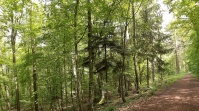
Halde Grühlingstraße - City-Marketing Saarbrücken GmbH
Halde Grühlingshöhe - City-Marketing Saarbrücken GmbH
Halde Grühlingshöhe - City-Marketing Saarbrücken GmbH
Halde Grühlingshöhe - City-Marketing Saarbrücken GmbH
When hard coal was mined, "dead", i.e. non-coal-bearing rock inevitably accumulated. In the past, attempts were made to keep these so-called "mountains" out of the extraction process as far as possible, so that the "mountain share" of the extraction remained low. However, the mechanisation of coal mining drastically increased the amount of "dead" rock. The resulting pointed cone, which was thus erected between 1957 and 1968, still rises 65 m above the natural relief. At the summit, the visitor stands 325 m above sea level on about 1.5 million m3 of overburden.
In 1994, as part of the "Saar Regional Park" project, the summit was given a cross that can be seen from afar, and a viewing platform, as well as a "Literary Ascent of Thoughts" were also built. Fourteen stone steps accompany the visitor on the way to the summit; parts of the poem "The Children of the Dead" by Elfriede Jelinek are engraved on each step. A refurbishment was carried out here in 2020 with funds from the RAG Foundation, the regional capital city of Saarbrücken and the Ministry of Education and Culture.
The deep erosion channels on the slagheap are particularly impressive; they form a very special forest landscape towards the Fischbach valley. At the foot of the slagheap is a small biotope - The iron-rich waters of the slagheap colour the mud red. On the slopes, in addition to rare mosses, the typical pioneer woods such as birch, pine and larch can be naturally found. These species can still cope with the nutrient-poor soil and the weather conditions there.